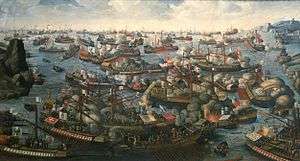Lepanto (poem)
"Lepanto" is a poem by G. K. Chesterton celebrating the victory of the Holy League in the Battle of Lepanto written in irregular stanzas of rhyming, roughly paeonic tetrameter couplets, often ending in a quatrain of four dimeter lines. The poem tells of the defeat of the Ottoman fleet of Ali Pasha by the Christian crusader, Don John of Austria. The poem was written in 1911 and published in Chesterton's 1915 collection Poems.

The poem's stirring verses helped inspire soldiers such as John Buchan during World War I.[1]
Analysis
Literary critic Joseph John Reilly described the poem as perfect: "Here Chesterton's vision of life is fulfilled and justified; here the mighty virtues of his world are made glorious anew in the immortal heroism of common men. ... In Lepanto, Chesterton reveals all his poetic gifts at their best: rhetoric in the high sense which De Quincey defined it; music almost as rich as Tennyson's, varied by a chant in which the tread of marching men lives again; color varied and brilliant with the splendor of the East."
Reilly praises the way that Chesterton artistically relieves the martial vigour with contrasting lines which are soft and quiet. For example, lines 5–7 of the following passage are identified as achieving this effect:[2]
Dim drums throbbing, in the hills half heard,
Where only on a nameless throne a crownless prince has stirred,
Where, risen from a doubtful seat and half attainted stall,
The last knight of Europe takes weapons from the wall,
The last and lingering troubadour to whom the bird has sung,
That once went singing southward when all the world was young.
In that enormous silence, tiny and unafraid,
Comes up along a winding road the noise of the Crusade.[3]— lines 15-22
This subtle restraint is especially praised in the way that the poem ends with a literary reference to Cervantes, who fought in the battle. "Don John did more than save western Europe: ... he made it possible for men unborn to dwell in freedom and to share the kindly and immortal laughter of Don Quixote."
Cervantes on his galley sets the sword back in the sheath
(Don John of Austria rides homeward with a wreath.)
And he sees across a weary land a straggling road in Spain,
Up which a lean and foolish knight forever rides in vain,
And he smiles, but not as Sultans smile, and settles back the blade. ...
(But Don John of Austria rides home from the Crusade.)[3]— lines 137-142
Context
"Lepanto" was published in 1915, and is in line with the author's other works of early decades of the century as representing a spirited rejection of the fin de siècle Decadent Fatalism which was the dominating philosophy in his youth.[4] As in the author's "The Ballad of the White Horse," the non-Christian forces are made representative of the determinist or fatalist philosophy that (in Chesterton's view) denied the value of human struggle and free will, and which he variously personified as pagan or Germanic (as in "The Ballad of the White Horse") or Mohammedan or Calvinist (as in this poem).[5] In "Lepanto," it is ironically Mahound himself, not Don John or Cervantes, who makes the clearest assessment of his Christian enemy's motivation and values: "It is he that saith not 'Kismet'; it is he that knows not Fate".
In World War I, the Turkish Ottoman Empire had become an ally of the Prussian enemy whom Chesterton saw as the perfect epitome of Paganism, Germanism, Imperialism, and Determinist Materialism. In this context, the victory of Christian Europe over its Turkish enemy depicted by Chesterton in vividly blood-stained terms became readily acceptable to those sympathetic to the British cause as a straightforward allegory of right — the Allied nations representing the traditional morality of Christendom — triumphing over wrong — the Central Powers representing the rejection of that morality in the name of the previously mentioned "-isms".[6] In the same context, the figure of Don John, "tiny and unafraid," was taken as representing England itself, a tiny nation standing against what then seemed to many Englishmen (and others) a vast hegemony of powerful, un-Christian states.
References
- Harry Blamires (1983), A Guide to Twentieth Century Literature in English, Taylor & Francis, p. 51, ISBN 9780416364507
- Joseph John Reilly (1968), "Chesterton as poet", Of Books and Men, Ayer Publishing, pp. 73–75, ISBN 9780836908176
- Chesterton, G. K. (1915). Poems. New York: John Lane. pp. 21-28.
- Vide the poet's description of the period in his Autobiography and his "Dedication to Edmund Clerihew Bentley" in The Man Who Was Thursday.
- The line "And Christian dreadeth Christ that hath a newer face of Doom" is the expression of Chesterton's conviction that the Calvinist belief in Predestination was a nominally Christian variation on the same (to him) horrifying idea of Determinism: note the word "Doom," which mirrors "Mahound's" use of "Kismet" and "Fate".
- Peter Faulkner (1995), "Introduction", The Works of G.K. Chesterton, Wordsworth Editions Ltd, p. vii, ISBN 1-85326-428-8
External links
| Wikisource has original text related to this article: |